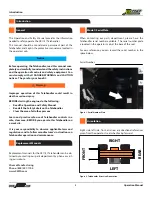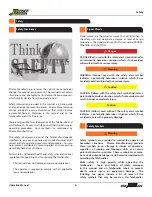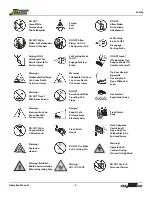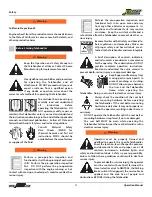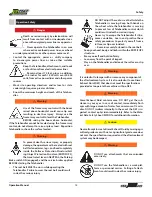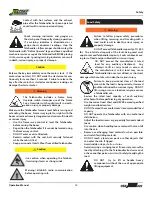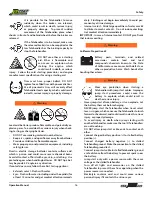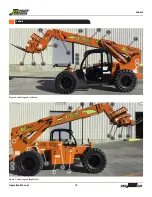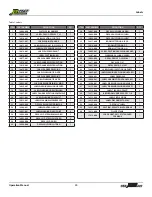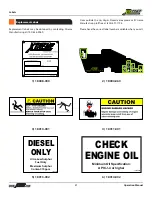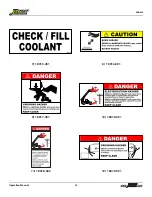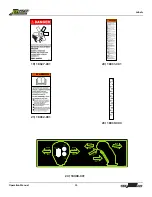
Operation Manual
9
Safety
Employer Responsibility
Operator Responsibility
Modifications
Warning
Warning
Telehandlers are potentially dangerous if proper safety
procedures are not followed. Workers who operate,
maintain, or work near the Telehandler can be at risk of roll
over and run over incidents or can be crushed or caught by
the Telehandler or its parts which could result in death or
serious injury if the Telehandler is not properly operated or
maintained.
Read the Operation and Safety
Manual BEFORE operating the
Telehandler. Follow all safety
instructions and labels. Only
operate the Telehandler if you
understand the safety instructions and warnings in all ap-
plicable manuals and technical publications. Always follow
all State and Federal health and safety laws and/or local reg-
ulations.
You must have the required training, skills, and tools to per-
form installation, operation, maintenance, or repair proce-
dures properly and safely. Make sure the Telehandler and
attachments will not be damaged or made unsafe by any
procedures you choose.
Operator Qualifications
Modifications to the Telehandler or
attachments could affect Telehandler capacity
and/or stability which could result in death or
serious injury. DO NOT make modifications
to the Telehandler or attachments without
prior written approval from the manufacturer. Where
such authorization is granted, capacity, operation, and
maintenance instruction plates, tags, or labels shall be
changed accordingly.
•
Unauthorized modifications or alterations will void the
warranty.
•
DO NOT modify, disable, or bypass any safety devices.
•
DO NOT burn or drill holes in forks or other attachments.
Structural damage, modification, or alter-
ation, including welding or drilling, can im-
pair and weaken the protective capability
of the Rollover Protective Structure/Falling
Object Protective Structure (ROPS/FOPS) and
could result in death or serious injury.
•
Replace the ROPS/FOPS, if it is damaged, before
operating the Telehandler.
Under Occupational Safety and Health Administration (OSHA)
rules, employers are required to train workers about hazards
related to operating and maintaining the Telehandler. Suc-
cessful completion and certification of the Safety Training for
Rough Terrain Telehandlers is required.
Additional safety information and training resources can be
obtained through these publications, organizations, and/or
appropriate sources:
•
(29CFR) Code of Federal Regulations.
•
(OSHA) Occupational Safety and Health Administration.
•
(NIOSH) National Institute for Occupational Health and
Safety.
•
(ANSI) American National Standards Institute
•
(AEM) Association of Equipment Manufacturers
•
(ITSDF) Industrial Truck Standards Development
Foundation
Always consult Material Safety Data Sheets (MSDS) for chemi-
cal hazards and first aid instructions for any oil or lubricant be-
ing used. MSDS should be available from the manufacturer/
supplier of the fluid.
Operators must be in good physical and mental condition,
with appropriate reflexes, reaction time, vision, depth
perception, and hearing.
Operators must possess a valid, current driver’s license as
required for the work site; plus those required by applicable
State, Federal, and/or local laws:
Successful completion and certification of Safety Training for
Rough Terrain Telehandlers is required.
•
Operators must be properly instructed on how to operate
the Telehandler and attachments.
•
Operators must operate the Telehandler according to ALL
appropriate safety regulations.
•
Operator trainees must remain under constant
observation and supervision of an experienced operator.





